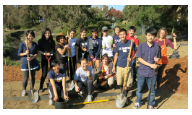Students begin the sequential development of all communicative skills. They use the language for oral and written communication, interpretation of spoken and written information, and presentations to audiences of listeners and readers. In addition, culture is an integral part of all communicative efforts because it is a natural component of language use.
|
Essential Question: How does communicating in more than one language create opportunities to connect with people from other cultures? |
||||
|
Unit Title and Time |
My Identity Quarter 1 |
My Free Time Quarter 2 |
My School Life Quarter 3 |
My Community Quarter 4 |
|
Image Cue |
 |
 |
|
 |
|
Focus of the Story |
Everyone has a story to tell about our lives, our families, and our culture. We will begin our language learning journey by learning how to introduce ourselves to others and describe what makes us unique. We will explore how we are similar to and different from our peers and those who live in places where the language we are learning is spoken. |
Our identity often connects to what we like to do with our free time. Culture shapes how we spend our free time and what we do for fun. We will continue to build our language skills as we identify and describe what activities we like to do in our free time. We will also explore how people who live in other parts of the world spend their free time and how it compares to the things we like to do. |
Going to school is a huge part of a teen’s daily life. As we build our vocabulary and learn to understand and express more complex ideas in the language we’re learning, we will discuss what school is like for us and explore how it compares to students in other cultures. |
In the final unit, we will turn to the wider world to explore what it means to be part of a community. We will identify and describe our favorite places and people in the local community and consider how communities are similar and different in other parts of the world. We will also reflect on how far we have come on our language learning journey and evaluate our progress toward reaching our goals for language proficiency. |
|
Transfer Goals |
|
|||
|
Learning Targets |
|
|
|
|

